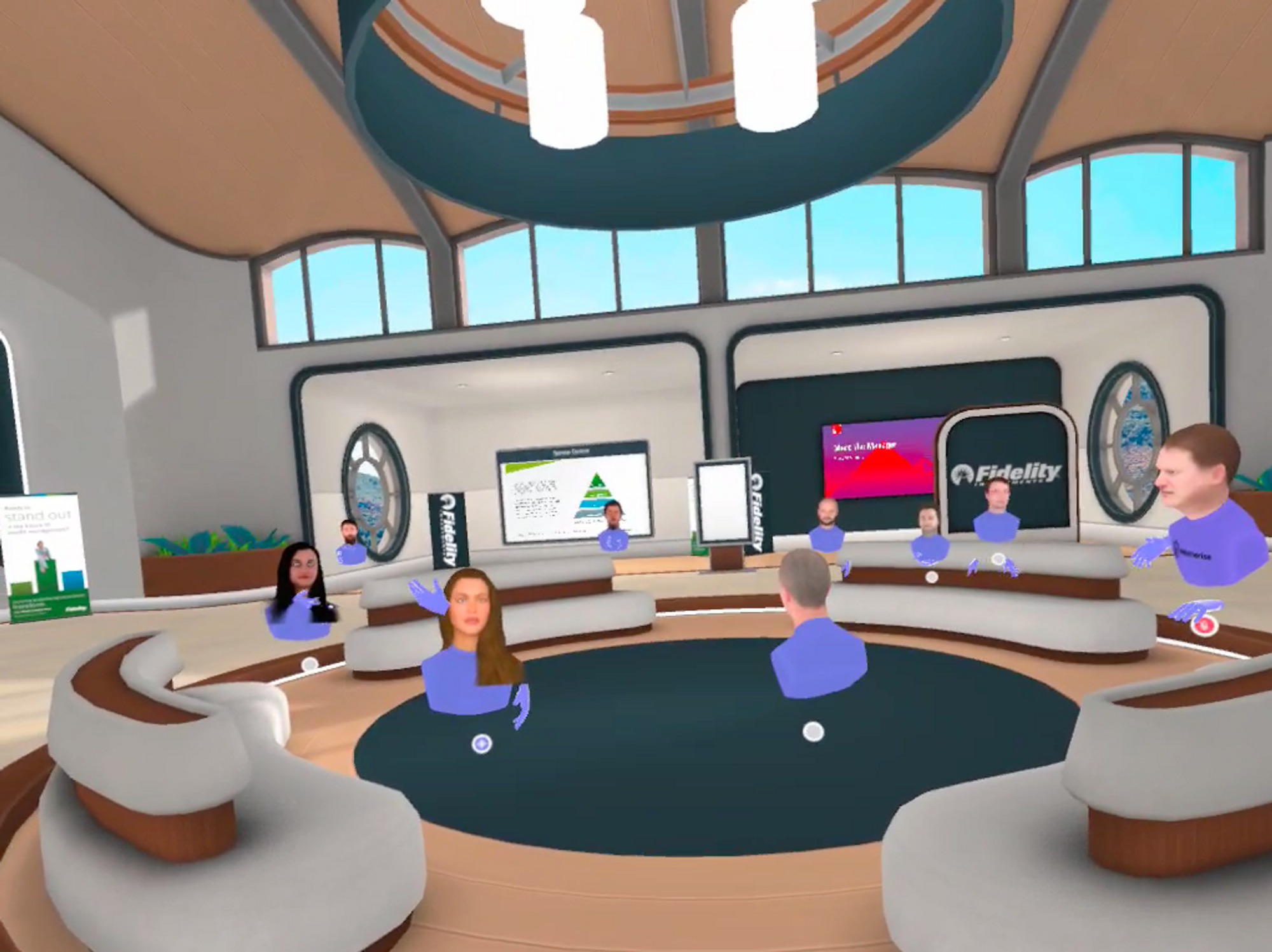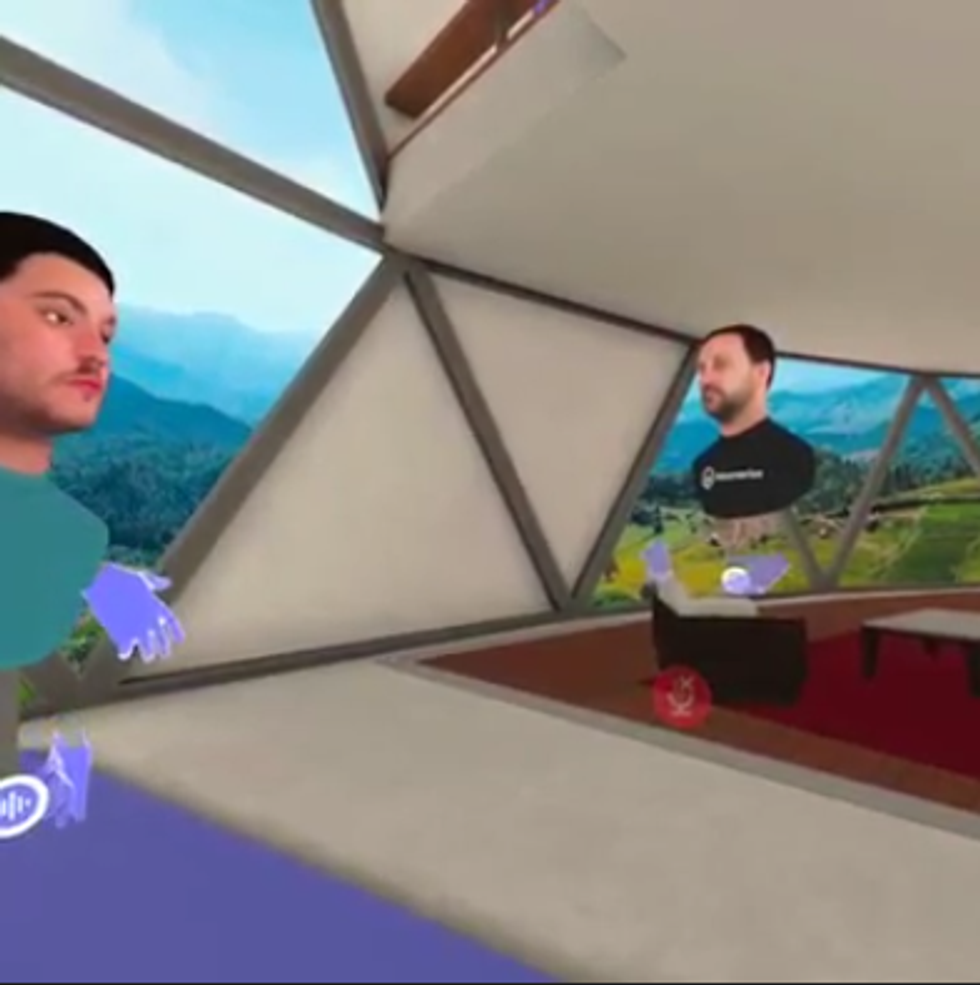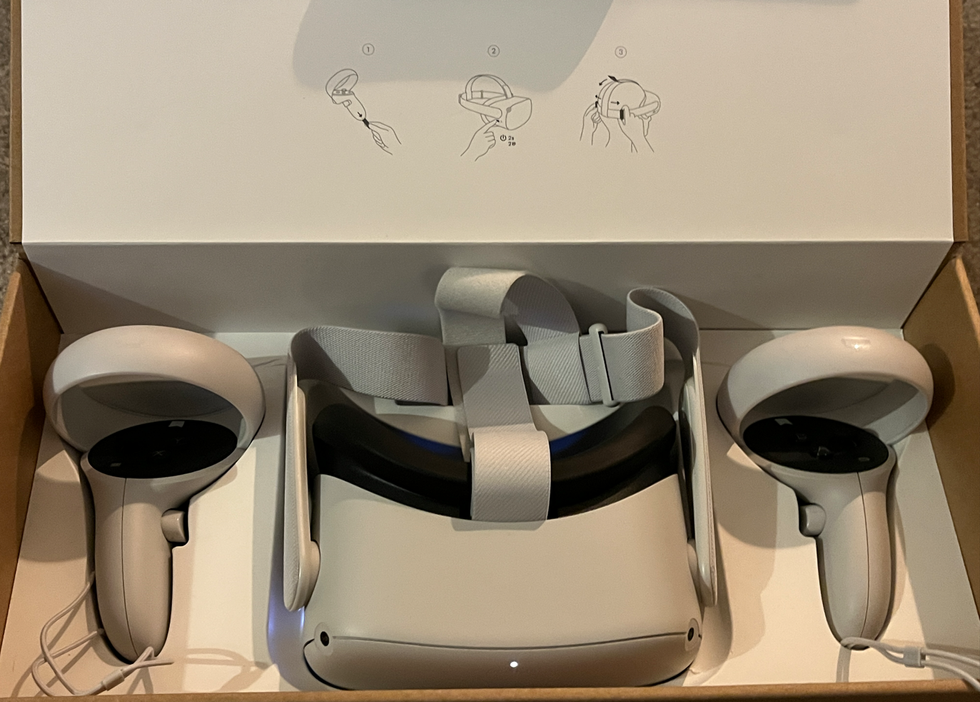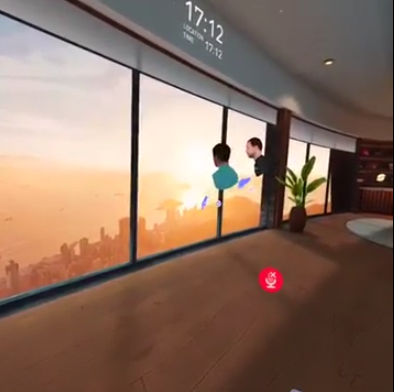Subscribe for free to finish this article!
Join tens of thousands of other founders, investors, and operators who subscribe to dot.LA for the most important tech news in their inbox 2x a week.
Get access to

Get in the KNOW
on LA Startups & Tech
XJoin tens of thousands of other founders, investors, and operators who subscribe to dot.LA for the most important tech news in their inbox 2x a week.
Get access to
Samson Amore is a reporter for dot.LA. He holds a degree in journalism from Emerson College. Send tips or pitches to samsonamore@dot.la and find him on Twitter @Samsonamore.

I’m standing in the center of my home office, feeling the full weight of the Oculus Quest 2 headset slouching on my forehead as I prepare for my first-ever virtual reality meeting.
With a few taps on my virtual Oculus home screen using my VR controllers, my avatar joins Gatherings’ advisory board chairman Sean West’s avatar in a minimalist dome-shaped building, well-lit, with a large, wooden arborous sculpture protruding from the center. The view outside the window is nice, a peaceful static rendering of Mediterranean farm country. This is the place Mesmerise refers to as its “Hub” — a virtual meeting space that connects to all of Gatherings’ other virtual conference rooms.

First impression? There’s clearly been a concerted effort to make the atmosphere of each meeting room futuristic but inviting. Mesmerise’s chief creative officer Michael Ogden, who’s spearheading the design efforts, is the former creative director for PlayStation Europe and is looking to bring gaming-quality graphics to the meeting software.
The avatars, however, are a different story. A day before the virtual meeting, I received the headset via Mesmerise inside my mailbox. The company also sent me detailed and straightforward instructions for how to onboard: Gatherings came pre-downloaded onto my headset, so all I had to do was boot up the app and enter a code that was previously generated for me to link my account.
A screenshot of my avatar in Mesmerise's VR meeting room. Photo: Mesmerise
After I was set up, I created my avatar by uploading a mug-shot style selfie to the Gatherings platform. Two minutes later I’m shown a preview of my digital avatar.
“Once you upload your photo we use a variety of services to create and refine the 3D model for your avatar, which we then bundle and publish so it can be shown dynamically in Gatherings,” West explains. “Our process is really focused on optimizing to get the right balance of visual fidelity and maximize the number of users in the space.”

Which means that for now, Mesmerise can only reproduce my head stitched onto the beginning of an upper body bust. “It’s optimized for the face, not the body,” West says, adding that “for business communication, we didn’t want to replicate walking.”
Not to mention, they can’t. Even with the $15 billion Mark Zuckerberg’s poured into Meta, the $244 billion company hasn’t cracked the code for realistically rendering a live lower body in VR. As part of its emerging Meta Horizon Worlds VR platform last month, Meta debuted their avatars with legs, but it was later revealed that the legs were instead added in post production before the demo, and not captured live.
In Gatherings, I also have no arms. I do have hands, though. And they float around wildly as I speak and gesture, sometimes overlapping each other while contorting in ways my body never could.

There’s no option to move your fingers in Gatherings either. The Quest 2 headset released in 2019 doesn’t have cameras in the headset or controllers to monitor hand movements. But, West tells me, the $1,500 Meta Quest Pro, which came out last month and which Mesmerise is still sourcing, has much more advanced motion capture tech and could make Mesmerise’s graphics more lifelike.
As for our conversation inside the virtual hub, the audio is clear but West’s avatar’s mouth struggles to keep up with his voice. It reminds me of an old dubbed Kung fu movie. In recordings, I notice my words also seem to emerge too fast for my lips to keep up.
As part of Gatherings, there’s also a feature in which a person can teleport to different places around the virtual rooms using the controller trigger. It does become difficult to hear West at times when he teleports around the room. This is because of spatial audio, a type of sound processing that is meant to simulate surround-sound to make headphone users feel more immersed. The audio feature is designed to make listeners feel that sound is coming from specific directions around them based on their distance to a speaker. It’s commonly used in video games, but becoming popular in VR.
The issue is that when West teleports more than a few feet away from me, his audio begins to fade out. I can only imagine then what it was like in a crowded event space, like the 200 person conference Gatherings recently held for the London School of Economics. Or the custom VR event space Mesmerise built for Morningstar’s Investment Conference—– a sweeping, expansive-open air courtyard made to look like a virtual town square and full of 4,000 virtual attendees.

Maxx Bricklin, a partner at LA-based Bold Capital Partners who’s been trying out Gatherings to see if it’s a good fit for his company, says that while he’s impressed with what Mesmerise has created, he doesn’t believe anyone is ready to have a heavy headset on for hours at a time. “Nobody wants to put that on their head,” he says, though he notes that VR components get lighter with each innovation, and says maybe by 2030 we’ll get there.
Bricklin recently tried Gatherings alongside a 65-year-old user. “I was in and operating within a minute, and it took 10 minutes-plus to get it right and to teach him,” Bricklin notes. “My biggest problem is just the huge lift that it takes to get anybody on a Mesmerise learning platform.”
West however tells me that the coronavirus pandemic gave Gatherings a boost. And that the platform might soon be for applications beyond business. “What’s happened in the VR market is everybody’s segmented, and we’re trying to be involved in each dimension,” he says.
Mesmerise’s practice of loaning headsets to users to access Gatherings could also help further overall adoption of VR, which is expected to grow to 70 million headsets worldwide in the next four years. Couple that with other use cases for VR— gaming, education, training and large-scale entertainment—and West believes it’s only a matter of time before we see large-scale VR adoption.
Yet another positive sign that people are slowly warming up to the technology is that Meta’s Oculus Quest 2 (the device I’m using) recently surpassed lifetime sales of the Xbox Series S and Series X, a 97% spike in sales since 2021.
In fact, an interest in entertainment is why Mesmerise chose Santa Monica to be its second home. “People in the entertainment industry have been developing VR for decades,” West says and the company wants to be near the action.
Though West wouldn’t disclose how much money is behind Gatherings, he says it hasn’t taken any outside investment and that some money is already flowing in as companies pay to use Gatherings for meetings. Right now, the company’s primary clients are financial institutions and large multinational corporations that are looking for an alternative to in-person conferences or Zoom meetings to hold live events.
Bricklin, for his part, says he does see a valid use case for VR to “augment” in-person relations in financial services, where he says a virtual client connection is “the highest value and emotionally complicated.” But VR technology overall, Bricklin says, “still [has] interoperability issues” and “puts a lot of creative onus on the users to develop the right use cases.”

My avatar, left, next to Mesmerise's advisory board chairman Sean West's avatar, right. Photo: Mesmerise

Even West acknowledges getting C-suites to onboard into Gatherings could be a problem. “Most executives don’t even manage their own calendars, some don’t even make their own coffee,” he says. West believes the slow adoption of VR is also due in part to the fact that people feel “vulnerable” in an environment where “you might reveal that you don’t know how this technology works, or you might do something silly.” His solution: make onboarding in Gatherings a thorough process that gives these newbies the feeling that they’re in control of the tech and can “harness the superpowers virtual reality gives you,” West says.
As for me and whether I’d be interested in conducting another meeting in VR? For now, it’s unlikely. Not only because I feel nauseous as I lift the headset off my face. But after reviewing the video of my avatar, I can’t help but be struck by the uncanniness of it. I know I look tired on Zoom in the mornings, but this avatar version of me looked simultaneously dead-eyed and like it had seen too much.
Samson Amore is a reporter for dot.LA. He holds a degree in journalism from Emerson College. Send tips or pitches to samsonamore@dot.la and find him on Twitter @Samsonamore.
Samson Amore is a reporter for dot.LA. He holds a degree in journalism from Emerson College. Send tips or pitches to samsonamore@dot.la and find him on Twitter @Samsonamore.
According to a Forbes report last April, both the viewership and dollars behind women’s sports at a collegiate and professional level are growing.
In 2022, the first 32 games of the NCAA tournament had record attendance levels, breaking records set back in 2004, and largely driven by the new and rapidly growing women’s NCAA tournament. WNBA openers this year saw a 21% spike in attendance, with some teams including the LA Sparks reporting triple-digit ticket sales growth, about 121% over 2022’s total. In 2023, the average size of an LA Sparks crowd swelled to 10,396 people, up from 4,701 people.
Women make up half the population, but “also 50% of the folks that are walking into the stadium at Dodger Stadium, or your NFL fans are just about 50% women,” noted Erin Storck, a panelist and senior analyst at Los Angeles-based Elysian Park Ventures.
Storck added that in heterosexual households, women generally manage most of the family’s money, giving them huge purchasing power, a potential advantage for female-run leagues. “There's an untapped revenue opportunity,” she noted.
In the soccer world, Los Angeles-based women’s soccer team Angel City FC has put in the work to become a household name, not just in LA County but across the nation. At an LA Tech Week panel hosted by Athlete Strategies about investing in sports, Angel City head of strategy and chief of staff Kari Fleischauer said that years before launching the women’s National Women’s Soccer League team, Angel City FC was pounding the pavement letting people know about the excitement ladies soccer can bring. She noted community is key, and that fostering a sense of engagement and safety at the team’s home venue, BMO stadium (formerly Banc of California Stadium), is one reason fans keep coming back.
Adding free metro rides to BMO stadium and private rooms for nursing fans to breastfeed or fans on the spectrum to avoid sensory overload, were just some of the ways ACFC tried to include its community in the concept of its stadium, Fleischauer said. She noted, though, that roughly 46% of Angel City fans are “straight white dudes hanging out with their bros.”
“Particularly [on] the woman's side, I'd like to think we do a better job of making sure that there's spaces for everyone,” Fleischauer told the audience. “One thing we realize is accessibility is a huge thing.”
Samson Amore is a reporter for dot.LA. He holds a degree in journalism from Emerson College. Send tips or pitches to samsonamore@dot.la and find him on Twitter @Samsonamore.
L.A. Tech Week has brought venture capitalists, founders and entrepreneurs from around the world to the California coast. With so many tech nerds in one place, it's easy to laugh, joke and reminisce about the future of tech in SoCal.
Here's what people are saying about the fifth day of L.A. Tech Week on social:
#LATechWeek has been on 🔥🔥🔥. Yes the events are super cool at amazing venues. But, I’m blown away by the people. I’ve met so many founders building generative AI companies from the ground up. I’m so bullish on LA right now🥳. LA is for builders #longLA
Thanks @rpnickson 📸 pic.twitter.com/B6rT2jJYIs
— Dr. Kelly O'Brien (@Kvo2013) June 8, 2023
Successful LatinxVC Avanza Summit 2023 in LA! It’s been an amazing few days near the beach w great company. Thank you to our panelists & participants.
Huge thanks to our incredible sponsors SVB, Chavez Family Foundation, Annenberg Foundation, PledgeLA, Fenwick & West, Countsy! pic.twitter.com/oVuGIgFurk
— LatinxVC (@LatinxVCs) June 9, 2023
30+ gaming startups presented at the A16z Speedrun Demo Day in LA yesterday. Great thanks to the @a16zGames team for an awesome day of events! #LATechWeek pic.twitter.com/DKq8IFo5QZ
— Grace Zhou (@graceminzhou) June 9, 2023
📣🤩 What’s the buzz? It’s #LATechWeek from @TechstarsLA & @TechstarsHealth joint demo day with the #Techstar HC team where our @fyelabs founder/CEO Suvojit Ghosh mentored both cohorts! #TechStars demo day highlighted 12 amazing emerging #startups in #healthtech #innovation. 🩺 pic.twitter.com/0RXClCtfDQ
— FYELABS (@fyelabs) June 9, 2023
Another successful Coffee On Slauson in the books for #LATechWeek.
Special thanks to the good people at Pledge LA, SVB and @GundersonLaw for the ongoing support and the @findyourhilltop staff for providing the space, eats & vibes. ♻️ pic.twitter.com/51cMDoEn30
— Slauson & Co. (@SlausonAndCo) June 9, 2023
The perfect combo to start #LATechWeek Day 5: pastries, coffee, and great convos with industry founders ✨
Fireside chats with @enriquealle, @wp, and @robynpark pic.twitter.com/booYPdekVV
— Tech Week (@Techweek_) June 9, 2023
Of course @designerfund has the most amazing pastries at their event. #LATechWeek pic.twitter.com/PjyWlGTQI4
— Jesse Pickard (@jessepickard) June 9, 2023
My favorite event from @Techweek_ has to be "Modern Storytelling & Business Building." Hosted by @STHoward #LATechWeek pic.twitter.com/SV1eexMJ4k
— JonnyZeller (@JonnyZeller) June 9, 2023
And the finale of the night was courtesy of the one and only @zedd for an unforgettable end to the "City of Games" party! Hosted by @a16zGames and @100Thieves #LATechWeek pic.twitter.com/hliI9yLKse
— Tech Week (@Techweek_) June 9, 2023
Excited to be at the @a16zGames Speedrun Demo Day! Loved the energy and excitement from the companies that pitched there. It was also great to see @Tocelot and @ndrewlee at this amazing #LATechWeek event pic.twitter.com/NfLQO5lR27
— Andy Lee | andypwlee.bit (@andypwlee) June 9, 2023
Thank you to everyone who joined the Sony Venture Fund US team at #LATechWeek for our screening of Spider-Man: Across the Spider-Verse. Last summer, we started building a presence in LA. Today, it's exciting to host such an event with the @Sony family and the LA VC community. pic.twitter.com/wdDm6qtHdL
— Sony Innovation Fund (@Sony_Innov_Fund) June 9, 2023
Time to eat, connect and build while @remi_rodney provided the vibes. 🙏🏽#LATechWeek @BuildOnBase @developer_dao @WeAreRazorfish pic.twitter.com/QIPh1gjvoA
— Hola Metaverso-Blockchain & New Web Tech Events 🎪 (@holametaverso) June 9, 2023
@Lux_Capital at #LATechWeek advancing the impossible to inevitable, from..
..defense primes partnering with cutting edge defense tech startups, to..
..hardware x LLMs improving mental health.
From the rich and diverse LA ecosystem stems generational companies: pic.twitter.com/v5S5r8JtbU
— Shahin Farshchi (@Farshchi) June 9, 2023
LA Tech Week has been a blast! Met some amazing creators, founders and investors from all over the world! #LATechWeek pic.twitter.com/AAh9JFELhe
— Chris Germano (@netslayer) June 9, 2023
Had such a blast at LA Tech Week and hosting events for @brexHQ
Top highlights were collabing with @pulley on an Emerging Managers / Founder mixer at the @poplco House, rooftop event in Venice, creator panel with @thechangj & proper Korean food with in KTown.
Exhausted is an… pic.twitter.com/mGQnSYGPdg
— Τyler Robinson (@TyyRob3) June 9, 2023
Did you have fun at @sophiaamoruso’s launch party for @trustfundvc? #LATechWeek pic.twitter.com/gbrbXRQ9Xx
— Kay (@KaySnels) June 9, 2023
y00tilty in every city with @KaylaLor3n & @cryptochrisg813.
Welcome to the LA @y00tsNFT fam! #LATechWeek #3XP week. pic.twitter.com/6wWKlsTacx
— VanG0xH (@CryptoVanGoghs) June 9, 2023
Really enjoyed #LATechWeek. Here are some observations I made 👇
— s.personal.ai (Suman Kanuganti) (@SumanPersonalAI) June 9, 2023
Thank you @TheKofiAmpadu for including me in #demoday with the latest @a16ztxo cohort! It was a real full circle moment to witness the brilliance of both @ChrisLyons & @ZMuse_ & #PledgeLA very own. She’s why we’re #LongLA 🚀💕 #LAtechweek pic.twitter.com/itkKXMxQRb
— Qiana Qiana! (@Q_i_a_n_a) June 9, 2023
@upfrontvc Gaming Founders Podcast #iLOVELA #LATechWeek @Techweek_ @KatiaAmeri @mucker @fikavc @bonfire_vc @TenOne10 @WatertowerGroup @ganasvc @IAmRobRyan @john_at_stonks @eva_ho @dereknorton pic.twitter.com/LCbaGXCoW7
— Sean Goldfaden (@seangoldfaden) June 9, 2023
Hosts Kevin Zhang, Partner at @upfrontvc, and Eden Chen, CEO of @pragmaplatform, interviewed two special guests from @raidbaseinc Stephen Lim, Co-Founder & Product Director, and Trevor Romleski, Co-Founder & Game Director. 🎙 #LATechWeek pic.twitter.com/hxHEAoELZ6
— Tech Week (@Techweek_) June 9, 2023
Kicking off @a16zGames @100Thieves City of Games party at #LATechWeek 🔥🔥🔥 pic.twitter.com/zQcZedG15f
— Jon Lai (@Tocelot) June 9, 2023
Yesterday at @socinnovation I got to have this AWESOME conversation with @iamwill — musician, producer, technology entrepreneur, and Founder & CEO of https://t.co/D60y1e2JOu #LATechWeek pic.twitter.com/KBxK6rXyTG
— Anna Barber (@annawbarber) June 9, 2023
I absolutely love this game. Proud moment for the team @investwithatlas. #LATechWeek pic.twitter.com/fPZvKXU7TC
— Tobias Francis (@TobiasFrancis) June 9, 2023
Had a blast at LA Tech Week this year with @brexHQ
From hosting & moderating my first creator panel featuring @BlakeMichael14, to a fun rooftop night in Venice, and to attending some amazing events such as Watertower’s emerging manager panel and a VC/founder tennis tournament pic.twitter.com/udjfmLHE0L
— Jonathan Chang (@thechangj) June 8, 2023
Samson Amore is a reporter for dot.LA. He holds a degree in journalism from Emerson College. Send tips or pitches to samsonamore@dot.la and find him on Twitter @Samsonamore.
At Lowercarbon Capital’s LA Tech Week event Thursday, the synergy between the region’s aerospace industry and greentech startups was clear.
The event sponsored by Lowercarbon, Climate Draft (and the defunct Silicon Valley Bank’s Climate Technology & Sustainability team) brought together a handful of local startups in Hawthorne not far from LAX, and many of the companies shared DNA with arguably the region’s most famous tech resident: SpaceX.
Here’s a look at the greentech startups that pitched during the Tech Week event, and how they think what they’re building could help solve the climate crisis.
Arbor: Based in El Segundo, this year-old startup is working to convert organic waste into energy and fresh water. At the same time, it also uses biomass carbon removal and storage to remove carbon from the atmosphere and sequester it in an attempt to avoid further damaging the earth’s ozone layer. At the Tech Week event Thursday, Arbor CEO Brad Hartwig told a stunned crowd that Arbor aims to remove about five billion tons of organic waste from landfills and turn that into about 6 PWh, or a quarter of the global electricity need, each year. Hartwig is an alumni of SpaceX; he was a manufacturing engineer on the Crew Dragon engines from 2016-2018 and later a flight test engineer at Kitty Hawk.
Antora: Sunnyvale-based Antora Energy was founded in 2017, making it one of the oldest companies on the pitching block during the event. Backed by investors including the National Science Foundation and Los Angeles-based Overture VC, Antora has raised roughly $57 million to date, most recently a $50 million round last February. Chief operating officer Justin Briggs said Antora’s goal is to modernize and popularize thermal energy storage using ultra-hot carbon. Massive heated carbon blocks can give off thermal energy, which Antora’s proprietary batteries then absorb and store as energy. It’s an ambitious goal, but one the world needs at scale to green its energy footprint. According to Briggs, “the biggest challenge is how can we turn back variable intermittent renewable electricity into something that's reliable and on demand, so we can use it to provide energy to everything we need.”
Arc: Hosting the panel was Arc, an electric boating company that’s gained surprising momentum, moving from design to delivering its first e-boats in just two years of existence. Founded in 2021, the company’s already 70 employees strong and has already sold some of its first e-boats to customers willing to pay the luxury price tag, CTO Ryan Cook said Thursday. Cook said that to meet the power needs of a battery-powered speedboat, the Arc team designed the vehicle around the battery pack with the goal of it being competitive with gas boats when compared to range and cost of gas. But on the pricing side, it’s not cheap. Arc’s flagship vessel, the Arc One is expected to cost roughly $300,000. During the panel, Cook compared the boat to being “like an early Tesla Roadster.” To date Arc Boats has raised just over $35 million, according to PitchBook, from investors including Kevin Durant, Will Smith and Sean “Diddy” Combs.
Clarity Technology: Carbon removal startup Clarity is based in LA and was founded by Yale graduate and CEO Glen Meyerowitz last year. Clarity is working to make “gigaton solutions for gigaton problems.” Their aim? To remove up to 2,000 billion pounds of carbon from the atmosphere through direct air capture, a process which uses massive fans to move chemicals that capture CO2. But the challenge, Meyerowitz noted in his speech, is doing this at scale in a way that makes an actual dent in the planet’s emissions while also efficiently using the electricity needed to do so. Meyerowitz spent nearly five years working as an engineer for SpaceX in Texas, and added he’s looking to transfer those learnings into Clarity.
Parallel Systems: Based in Downtown LA’s Arts District, this startup is building zero-emission rail vehicles that are capable of long-haul journeys otherwise done by a trucking company. The estimated $700 billion trucking industry, Parallel Systems CEO Matt Soule said, is ripe for an overhaul and could benefit from moving some of its goods off-road to electric railcars. According to Soule, Parallel’s electric battery-powered rail vehicles use 25% of the energy a semi truck uses, and at a competitive cost. Funded in part by a February 2022 grant from the U.S. Department of Energy, Parallel Systems has raised about $57 million to date. Its most recent venture funding round was a $49 million Series A led by Santa Monica-based VC Anthos Capital. Local VCs including Riot Ventures and Santa Monica-based Embark Ventures are also backers of Parallel.
Terra Talent: Unlike the rest of the startups pitching at the Tech Week event, Terra Talent was focused on building teams rather than technology. Founder Dolly Singh worked at SpaceX, Oculus and Citadel as a headhunter, and now runs Terra, a talent and advisory firm that helps companies recruit top talent in the greentech space. But, she said, she’s concerned that all the work these startups are doing won’t matter unless we very quickly turn around the current trendlines. “Earth will shake us off like and she will do just fine in 10,000 years,” she said. “It’s our way of living, everything we love is actually here on earth… there’s nothing I love on Mars,” adding that she’s hopeful the startups that pitched during the event will be instrumental in making sure the planet stays habitable for a little while longer.
Samson Amore is a reporter for dot.LA. He holds a degree in journalism from Emerson College. Send tips or pitches to samsonamore@dot.la and find him on Twitter @Samsonamore.